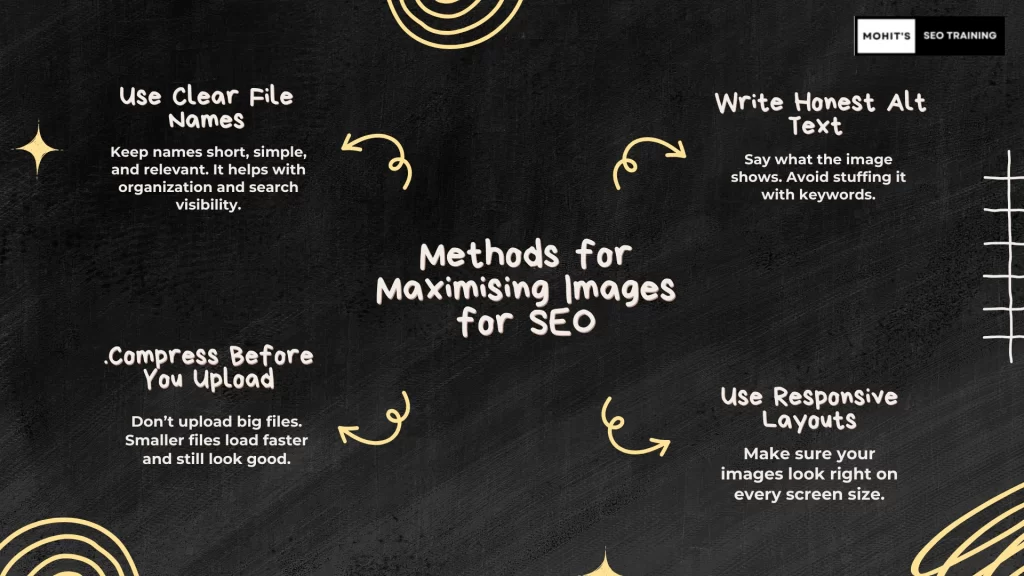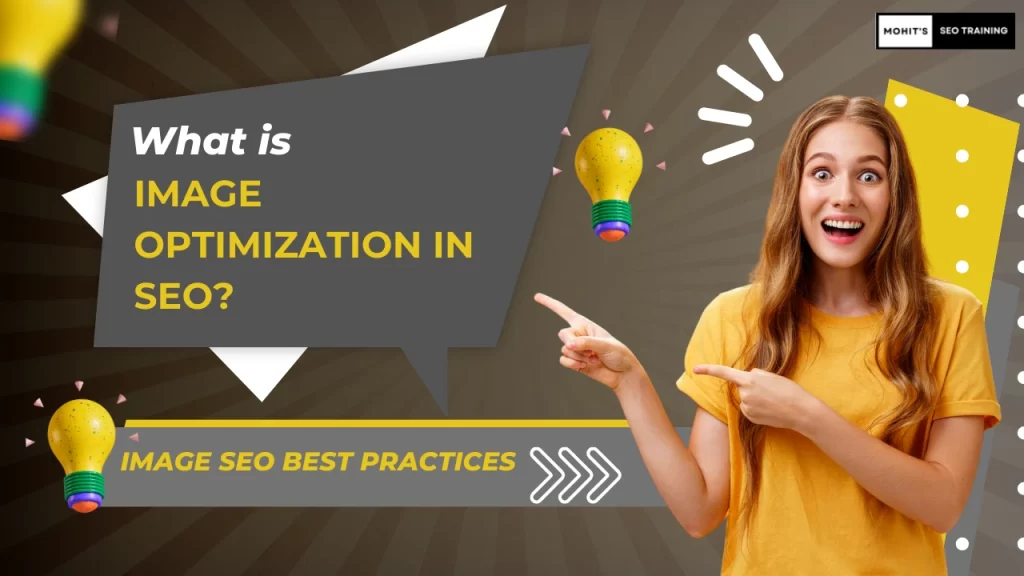When individuals think about SEO they typically think about words — headlines, headings, meta tags, or backlinks. Images too are quietly, and pending consideration of your onsite SEO, powerfully implicated in the performance of your website.
If the images aren’t sized properly and/or they are poorly named (i.e., using numbers instead of words) and/or they are missing appropriate descriptions (a.k.a. ALT tags), then they are inflating page sizes enough to slow down the site and missing to suggest themselves in search results. On the other hand, when correctly applied, images that are optimized can speed it up, add accessibility elements, and rank even higher than matching sites.
This asset explains image optimization in the simplest of terms regarding SEO and shows how to put them into place on your website.
In this blog, we’ll break down:
What is Image Optimization in SEO?
Why Image Optimization Matters for SEO
Best Image Format for SEO: A Simple Breakdown
How to Do Image Optimization in SEO
Methods for Maximising Images for SEO
What is Image Optimization in SEO?
SEO image optimization means getting your images ready for the web in a smart and simple way. The aim is to ensure the images load quickly and provide enough information for search engines to understand what it is. It is done to rank on Google images, and to make sure the images are accessible to the visually impaired users as well.
This means giving your image a good name, using the appropriate file format, compressing it (so as not to cause your site to slow), and writing a brief description (alt-text) that explains what the image is showing.
When you do all this, your pages not only load faster but also become easier to find in search results — both for users and for Google.
If you skip these steps, your pages might load slowly and search engines won’t fully understand your content. Done well, image SEO helps both users and search bots.
Why Image Optimization Matters for SEO
Search engines can’t see pictures the way we do. They rely on words and file info to understand what an image is about. That’s where optimization comes in.
When your images are optimized:
- Your website loads faster
- People get a smoother experience
- Your images can appear in image search results
- Your site becomes more accessible for all users
Best Image Format for SEO: A Simple Breakdown
When it comes to SEO, choosing the right image format can boost your page speed, improve user experience, and help you rank better on Google. But there’s no one-size-fits-all answer — the best image format depends on your website’s purpose.
Let’s break it down:
1. For Business Websites (e.g., service providers, blogs, eCommerce)
Best Formats:
- WebP – Lightweight, fast, and supported by most browsers. It provides excellent quality at smaller file sizes, which improves load speed (a known Google ranking factor).
- JPEG (or JPG) – Good for photographs or detailed visuals, but larger in size than WebP.
- PNG – Best for logos, transparent images, or graphics with fewer colors.
Why it matters:
Your goal is fast loading and clean visuals. WebP is ideal here because it keeps your website light and snappy while maintaining decent quality.
2. For Stock Photo Websites or Photography Portfolios
Best Formats:
- JPEG – Still the king for high-quality photographs. It maintains rich detail and is widely compatible.
- WebP (with fallback to JPEG) – Use WebP as the default and serve JPEG to older browsers for better performance.
- TIFF or RAW (only for downloadable files) – If you’re offering high-res downloads, use these for quality. But never for web display — they’re too large.
Why it matters:
Users expect image quality over speed. So JPEG or high-resolution formats make sense here, but always compress before uploading.
3. Other Things to Consider for Image SEO
- Always compress images before uploading (use tools like TinyPNG, Squoosh, or ShortPixel).
- Use descriptive filenames (e.g., sunset-beach-goa.jpg instead of IMG1234.jpg).
- Add alt text – Describe the image for accessibility and better indexing by search engines.
- Use responsive images – Make sure they load well on all devices.
How to Do Image Optimization in SEO
Here’s how to get it right from the start:
1. Rename the Image File with Clear Words
Instead of something like IMG_001.jpg, go for a meaningful name like chocolate-chip-cookies.jpg.
Benefit:
Search engines better understand your image content, improving chances of ranking in Google Images and boosting page relevance.
2. Add Alt Text That Describes the Image
Alt text is a short line that tells what the image is about. Example: “freshly baked chocolate chip cookies on a tray.”
Benefit:
Helps with image SEO and improves accessibility for screen readers, enhancing user experience and inclusivity.
3. Compress Images Without Losing Quality
Big images make your site slow. Use free tools like TinyPNG, Squoosh, or ShortPixel to reduce size without ruining clarity.
Benefit:
Faster loading times = lower bounce rates + better Google rankings. It also improves mobile performance.
4. Choose the Right File Type
- JPEG for regular photos
- PNG for transparent or sharp graphics
- WebP for best of both – small size + quality
Benefit:
Better visuals with faster load times, helping both UX and SEO. WebP especially reduces file size without sacrificing detail.
5. Make Images Mobile-Friendly
Use responsive design or the srcset attribute in HTML to let images resize based on screen size.
Benefit:
Keeps your site looking clean on all devices, reduces mobile bounce rates, and earns you points in Google’s mobile-first indexing.
6. Use Schema Markup If Needed
If you’re showcasing products, recipes, or events, add image-related structured data using schema.org.
Benefit:
Your images can appear in rich results (like Google Shopping or recipe snippets), increasing click-through rates and visibility.

Methods for Maximising Images for SEO
Let us now go over all you can do to raise the SEO value of your photos:
1. Use Clear File Names
Keep names short, simple, and relevant. It helps with organization and search visibility.
2. Write Honest Alt Text
Say what the image shows. Avoid stuffing it with keywords.
3.Compress Before You Upload
Don’t upload big files. Smaller files load faster and still look good.
Here’s how to do it, step by step:
- Pick the Right File Format
- Use JPEG for normal photos
- Use PNG for images with transparent backgrounds
- Use WebP for the best balance between quality and size
- Use JPEG for normal photos
- Use Free Tools to Compress Images Online
You don’t need any software. Just drag and drop your image into one of these websites:- TinyPNG – Best for JPEG and PNG
- Squoosh – Lets you adjust compression level and even convert to WebP
- ImageCompressor – Works with multiple formats
- Compressor.io – For high-quality, quick compression
- TinyPNG – Best for JPEG and PNG
- Steps to Compress (Example with TinyPNG):
- Visit tinypng.com
- Upload your image (just drag and drop)
- It compresses it automatically
- Click Download to get the smaller, optimized version
- Visit tinypng.com
- Check File Size
Try to keep image size under 200 KB for most website uses.
For icons and thumbnails, aim for under 100 KB. - Upload to Your Website
Use the compressed image on your site.
Don’t forget to:- Rename the file with clear words (example-product-image.jpg)
- Add alt text to help search engines and accessibility tools
- Rename the file with clear words (example-product-image.jpg)
Result? Your page loads faster, performs better on SEO, and looks just as good.
4. Use Responsive Layouts
Make sure your images look right on every screen size.
5. Add Captions When Helpful
Captions can guide the reader or add context—but only if they’re needed.
SEO Image Naming Best Practices
- Keep it short and specific
- Use hyphens between words (not underscores)
- Avoid meaningless names like “pic1.jpg”
- This makes your files easier to track and understand for both people and search engines.
Image SEO Tips You Can Start Using Today
Here are some small things you can do that make a big difference:
- Turn on lazy loading so images load as users scroll
- Store images on your own server if possible
- Build an image sitemap to help search engines find them
- Skip adding alt text for purely decorative images
- Use schema markup where appropriate
Image SEO Best Practices Checklist
| Task | Why It’s Useful |
| File names with meaning | Gives Google context about the image |
| Descriptive alt text | Improves SEO and accessibility |
| Right file type | Reduces load time without losing quality |
| Compression | Keeps your site running fast |
| Mobile responsiveness | Makes sure images look good on every device |
Conclusion: Make Every Image Count
Image optimization is not difficult, but it is often overlooked. Assuming that you get it right, image optimization makes your website easier to maintain, better ranked, and provides visitors with a better experience.
If you’ve ever asked “What is image SEO?” now you know. It’s about giving your images the same attention as your text, and helping search engines and users make sense of them.
Take a few minutes to rename your files, add alt text, and compress your images. These simple steps will go a long way.
FAQs
What is image optimization in SEO?
Image optimization in SEO is the process of preparing images so they load quickly and provide helpful context for search engines. It includes using descriptive file names, writing alt text, compressing image size, and selecting the right format.
Why is image SEO important?
Optimized images help your site load faster, improve user experience, and increase your chances of ranking in image search results. It also makes your site more accessible to all users.
What is the best image format for SEO?
JPEG is ideal for most photos, PNG works well for transparency, and WebP provides high-quality images with smaller file sizes, making it a great all-around option.
How do I write alt text for images?
Alt text should be a short, accurate description of the image. Keep it natural and avoid keyword stuffing. Think of it as a simple way to explain the image to someone who can’t see it.
Should I compress every image before uploading?
Yes, compressing images helps reduce file size without losing quality. This improves page speed, which benefits SEO and provides a smoother user experience.
Mohit Verma
I am an experienced professional with 9+ years of experience in Search Engine Optimization. I am on a mission to provide industry focused job oriented SEO so the students/mentees can get their dream SEO job and and start working from day 1.
